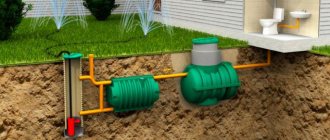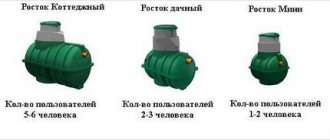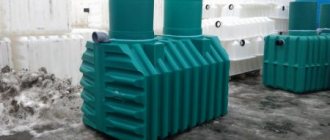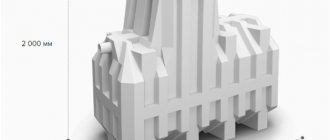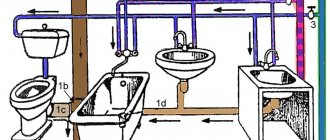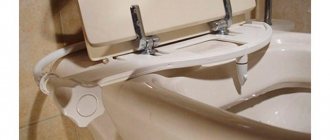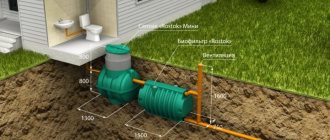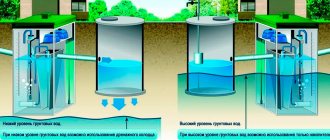Modern people value comfort, so even when relaxing in the country, no one wants to give up their usual amenities. Moreover, modern treatment plants make it possible to quickly build an efficiently operating local sewage system that can serve a country house. Today there is no need to build septic tank chambers yourself; you can purchase a model that is completely ready for installation, for example, a Rostok dacha septic tank.
GC "EkoProm" is a manufacturer that specializes in the production of polyethylene products, including treatment plants for the construction of local sewage systems. The manufacturer offers a variety of products that are characterized by a high degree of reliability, efficient operation and affordable cost.
One of the main competitors of inexpensive homemade septic tanks is the Rostock treatment plant. The model is available in three performance options, so you can choose the most suitable installation for each private home.
The lineup
Rostock installations are presented in three versions, and their names speak for themselves. Manufacturers offer models:
- Mini;
- Dachny;
- Cottage.
Consider the technical characteristics of the models.
Mini
The youngest in the model range, the Rostock mini septic tank is capable of processing up to 250 liters of wastewater per day, the volume of its chambers is 1000 liters. This model is an ideal choice for a small country house in which 1 or 2 people live permanently.
You can use a mini septic tank even if the dacha is used only for periodic recreation, in this case, its productivity is enough to serve 3-4 people. The installation is quite compact, its dimensions are 1.28 x 1.1 x 1.7 meters.
Due to the fact that the body is made entirely of plastic, it is lightweight - only 24 kg. The body of the unit is solid cast, so it is absolutely sealed. And thanks to its cylindrical shape, the unit does not float, despite its light weight.
Dachny
The second most productive model, called the Dachny septic tank, is capable of processing up to 400 per day, and the volume of its chambers is increased to 1500 liters. Its overall dimensions are 1.7 x 1.12 x 1.84 meters. This version of the treatment plant will be quite capable of serving a small country house in which 2-3 people will permanently live.
The body of the septic tank has the shape of a horizontally oriented cylinder. It is 100% airtight because it is made using seamless technology.
Cottage
If you need a septic tank to process 1000 liters per day, you should choose a model called Cottage. The volume of the chambers of this installation is 3000 liters, dimensions are 2.36 x 1.44 x 2 meters. It will be able to serve a fairly large country house, which will accommodate 5-6 people.
The shape of the Cottage septic tank is the same as that of the “Dachny” option. The model has additional stiffening ribs, which provides the installation with the necessary strength.
Advice! All Rostock septic tank models are classified as non-volatile, that is, they do not require a power supply. Therefore, these models are perfect for use in holiday villages, even if the power supply there is unstable.
Advantages and disadvantages
Advantages of Rostock
The Rostock septic tank, like other similar devices, has its advantages and disadvantages. The first include the following:
- The body itself is made in one piece. Plus it has stiffening ribs. This design ensures high strength and durability of the product.
- Does not require connection to power supply. This feature makes it very popular when creating an autonomous sewage system in summer cottages and in settlements with poorly developed infrastructure.
- Has a fairly high degree of purification. If you add biological products with anaerobic bacteria, the level of sewage treatment can reach 92%.
- Easy to maintain and install. You can easily handle all the work yourself, without the involvement of expensive specialists.
- Thanks to the presence of a damper on the inlet pipe, the septic tank is not afraid of water hammer from a sudden discharge of a large amount of water.
Installation features
If we talk about shortcomings, there are not many of them. The disadvantages of the system include its relatively low weight. Because of this, there is a risk of the septic tank “floating” from the ground during seasonal rises in groundwater. The manufacturer, however, states that the Rostock septic tank is less susceptible to floating, but it is still better to make a concrete base (or lay a concrete slab on the bottom) and attach the septic tank to it. Disadvantages also include the need to periodically pump out accumulated sediment at the bottom of the septic tank. This will require calling a sewer truck, which means additional costs.
Design and principle of operation
Before purchasing a septic tank and improving your country house, it is worth getting acquainted with the principles of operation of the installations. Rostock is a model of a septic tank, divided inside into two chambers. The first of them is used for primary sedimentation, the second for additional filtration. The process of waste disposal proceeds as follows:
- The wastewater entering the first chamber through the supply pipe will be divided into several fractions, depending on the specific gravity (density). All substances that are lighter than water float to the top, heavier particles settle to the bottom;
- At the inlet of the supply pipe there is a special quenching device that does not allow the settled wastewater to be mixed again under the influence of a jet of liquid falling down;
- After settling, the initially clarified wastewater is sent to the next chamber – the filter chamber. There are two types of filters installed here - sorption and mesh.
Advice! The sorption filter is represented by a layer of zeolite 20 cm high. To maintain the installation in working condition, it is necessary to wash the sorption filter once a year with a solution of ordinary table salt.
After passing through the septic tank, the wastewater is approximately 75% cleared of impurities. To achieve final purification, the liquid is sent to a biofilter or to a soil treatment device - a filtration field.
The operating principle of a septic tank Rostock.
The use of a Rostock septic tank allows you to solve problems in the purification of sewage, removal and additional cleaning. After completing the entire cycle, the liquid can be reused. Sometimes utility networks are arranged so that the water flow after the purification system is directed into the ground. When installing a septic tank system, the soil will be filled with the cleanest possible water, without causing any harm to the environment.
The model of the purification system under the trade name Rostock consists of two reservoir chambers. The first one receives the waste material, where it settles and undergoes initial cleaning. During the settling process, heavy elements settle to the bottom, light particles and fats rise, leaving a purified water column in the center. Additional fermentation of the sewer mass is given by the presence of aerobic bacteria, which decompose solid masses to the state of sludge. In the second tank, the water flow is passed through additional filtration. The Rostock septic tank is equipped with two filters. The first is mesh; particles of a larger fraction settle on it. The second filter is loaded with activated carbon to purify the water stream from impurities and organics. Manufacturers guarantee purification of sewage disposal waters up to 95%.
Advantages
The most modern technologies were used in the design and production of Rostock septic tanks, so the models are efficient and reliable. This is also evidenced by consumer reviews. Here are the main advantages of the models:
- The one-piece body without seams ensures strength and complete tightness of the installation;
- The body is made in the form of a cylinder; this shape is optimal because it can withstand maximum loads and is less prone to floating than other forms;
- The installation is equipped with special overflow devices, which make it possible to separate fats and oils from wastewater;
- Rostock septic tanks are absolutely safe from an environmental point of view, they fully comply with sanitary standards, of course, provided that the performance is correctly selected and installed correctly;
- High cleaning efficiency. If an additional biofilter or filtration fields are used, the level of wastewater treatment is 95%;
- The thoughtfulness of the design protects the septic tank from emergency situations. The models are capable of withstanding volley discharges of wastewater in volumes of up to 200 liters. To prevent flooding, the model is equipped with an emergency overflow. In addition, a special device prevents large particles from entering the filtration chamber;
- Maintenance is simplified as much as possible. The manufacturer has provided easy access to all technological holes of the models.
Septic tank pumping
Like any other septic tank model, the Rostock installation needs periodic cleaning of accumulated sediment. The operating procedure is as follows:
- The lid is removed from the septic tank;
- The hose of the sewage disposal machine is inserted into the hatch of the primary settling chamber;
- The contents of the chamber are completely pumped out;
- Then the hose of the cesspool pump is inserted into the hatch of the second (filtration) chamber, after which its contents are pumped out;
- The septic tank is filled with clean water. First, the filtration chamber is filled, then the receiving chamber.
Installation ↑
Before installing a Rostock septic tank on your garden plot, you should determine its future location.
Important! To avoid problems with environmental safety, you need to install a septic tank at a distance of at least 5 m from a residential building, 30-50 m from a drinking well, 5 m from the road border, and at least 3-4 m from fruit trees.
Next, a pit is dug for the container you purchased. All dimensions of the structure are measured, and then a pit is dug to a slightly greater depth, width and length than the septic tank.
Typically, a distance of 300 mm from the septic tank to the walls of the pit is used, which is then filled with sand or sand-crushed stone backfill. All trenches for the sewer pipeline must be dug with a slope towards the septic tank of 20 mm by 1 meter.
Only in this way will the rate of supply of waste liquids be the most optimal and will not disrupt the operation of the autonomous treatment plant.
Photo: pit
The bottom of the pit must be provided with a cushion in the form of a bedding made of crushed stone and sand. If groundwater flows nearby, or you have to place a septic tank in the ground where it flows, then you need to support the entire structure on a concrete screed and secure it with belts, ropes or some kind of reinforcement. This is important to do so that the septic tank does not float up when it is emptied.
Photo: support on a concrete wall
The depth should be taken into account the freezing depth of the soil in your area. The plastic or polyethylene itself will not be damaged by exposure to low temperatures, but the liquid inside them may freeze.
This means that the entire process that should take place in the treatment plant will be suspended, and the sewerage system will not be able to be used until spring.
Once the pit is ready, you can lower the septic tank into it. The weight of the entire structure allows this to be done with the help of several people, so it is not necessary to use a crane or winch here.
Before installing the septic tank in the pit, it is important to make sure that there are no sharp stones, glass or protruding fittings anywhere that could damage the surface of the polyethylene walls of the septic tank.
Photo: installing a septic tank in a pit
Next, a route of sewer pipes with a diameter of 110 mm is connected. The pipes lie approximately from 1 to 1.5 m, and therefore this should be taken into account when installing a septic tank, so that there are no distortions with the depths, and the slope of the pipeline connected to the septic tank is not disturbed.
Photo: connecting communications
After all connections, the walls of the septic tank are sprinkled with sand or a sand-cement mixture without large and solid particles.
This will serve as both insulation and a kind of drainage for groundwater, which will simply wash the outer surface of the equipment.
Sprinkling must be done while gradually filling the septic tank with water and compacting each layer. We made a sprinkling, and then covered everything with soil, lightly compacting it.
Photo: filling a septic tank with soil and sand
For post-treatment, either filtration fields are used, which are networks of perforated pipes and areas lined with expanded clay, crushed stone or sand, or special tanks, which can also be supplied as an option for the Rostock septic tank.
Thanks to filtration fields, purified water goes into the ground without polluting the soil. 10 A filter well connected to the septic tank also serves as a water filter and discharges the already purified water into the ground.
Photo: filtration fields for post-treatment
An important condition for installing such a well is the absence of groundwater nearby, otherwise it will overflow the well, flowing back into it.
Photo: filter well
The same function can be performed by biofilters, which also look like a well container, but only contain special filters inside. The drainage of such water can be safely routed to a river or any body of water because it is absolutely safe.
Photo: purified water drainage
Installation recommendations
If the owners decide to improve their country house themselves, they will need to first familiarize themselves with the installation instructions. First of all, you need to choose a place to install a septic tank, taking into account sanitary standards, and prepare a pit at the chosen location.
At the bottom there is a cushion of sand and crushed stone. And if the water level at the construction site is high, then it is necessary to lay a reinforced concrete slab on top of the sand cushion and secure the septic tank body to it. Then you will need to connect communications to the septic tank - inlet and outlet pipes. After this, the pit is backfilled and the septic tank is insulated.
Septic tank maintenance Rostock
For long-term operation of the septic tank equipment, it is necessary to pump out liquid masses from the tanks once every one to three years using a sewer truck. Then, to remove deposited deposits on the bottom and walls of the tank, both chambers should be filled with water. Filters can be easily restored using saline solution.
Manufacturers guarantee effective operation with proper care of the Rostock septic tank for up to 50 years. The most important thing in care is high-quality filter cleaning.
To reduce plaque and sediment on the bottom and walls of the chambers, additional special bacteria can be used during cleaning.
Reviews
What customers say about this installation:
- We recently installed a Rostock mini septic tank at our dacha, but immediately appreciated all the amenities it provides. You get used to good things quickly, so now we remember with fear the basins and buckets that we used to carry before. But they haven’t yet realized how quickly the chambers fill up, and how often they will have to pump out.
- For a long time they did not decide to buy a plastic septic tank, because they were afraid that the body would not “survive the winter” and would be crushed by the soil. But the experience of our neighbors, who installed a septic tank in the Rostok Dacha option, convinced us. We looked at the neighbors, how people lived, and we were all running around with buckets, and bought ourselves a similar model. The septic tank worked successfully during the summer season and “survived” the winter well. So it was in vain that we delayed the purchase for so long.
So, you can use Rostock septic tanks to equip your dacha or home. These installations are simple and reliable, so they are deservedly popular among consumers. For a house in which the family will live permanently, a Rostock cottage septic tank is suitable; if the water consumption is small, you should choose the Country or Mini model.
